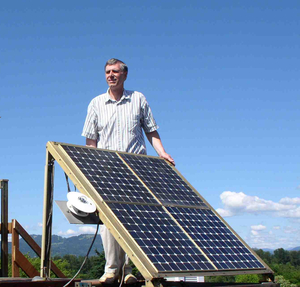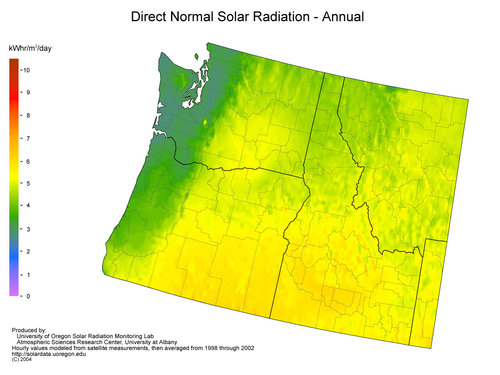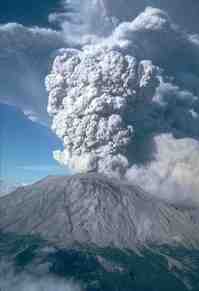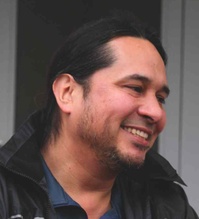 UO physicist Frank Vignola (right) has some surprising news for the sun-deprived denizens of Oregon and its dour winters. About two-thirds of the Northwest gets as much solar radiation as Florida.
UO physicist Frank Vignola (right) has some surprising news for the sun-deprived denizens of Oregon and its dour winters. About two-thirds of the Northwest gets as much solar radiation as Florida.
Even Astoria, considered by many the grayest and cloudiest city in the state, gets as much sun power as Germany.
The Southwest is the region of the U.S. with the most bountiful supply of solar power, but Eugene is no slouch either; it's right on the national average, Vignola says.
Since 1977, Vignola has spearheaded efforts at the UO's Solar Radiation Monitoring Lab (SRML) to collect data at various solar stations throughout the Northwest to help paint a more reliable picture of the potential of solar power.
"Really you're talking about small differences among these places we're monitoring," he said. "But because solar power is so expensive, these extra percentage points become vitally important."
 Transmission costs, the cost of buying land and the cost of manufacturing solar cells all add up, making solar production a very expensive proposition. Thus one of Vignola's aims is to provide entrepreneurs the data they need to bankroll major solar endeavors. Investors want solid scientific evidence that projects will be able to produce as much power as anticipated.
Transmission costs, the cost of buying land and the cost of manufacturing solar cells all add up, making solar production a very expensive proposition. Thus one of Vignola's aims is to provide entrepreneurs the data they need to bankroll major solar endeavors. Investors want solid scientific evidence that projects will be able to produce as much power as anticipated.
The more longitudinal and accurate the data, the more likely a convincing case can be made for a given solar power project.
Because SRML has been measuring solar radiation for more than three decades, Vignola hopes this will put Oregon in prime position to be a hub of future solar energy production and innovation. Other states that are currently leading efforts, like California, have not collected nearly as much information as Vignola's team, and this, he says, will probably end up hurting them.
"It's tough in California. Investors and banks will make you jump through hoops to get funding for a project," he said. "If your production estimates aren't backed up with hard data, the banks will play it safe and fund you based on the lowest estimates."
Interestingly, Vignola's data also shows that Oregon's solar radiation has increased by 10 to 15 percent in the last three decades, which could be linked to global warming. A UO graduate did her dissertation studying this phenomenon and is currently investigating climate change at Battelle, an international science and technology enterprise.
The SRML monitoring labs, which dot the landscape from Oregon to Idaho, are also interesting bellwethers for global pollution. About half a percent of the increase in solar radiation over the past 30 years is related to cleaner air, as airborne detritus from volcanic eruptions and pollution have been reduced. Yet sometimes pollution from halfway across the world affects Oregon's sunlight, such as a recent dust storm in China's Gobi Desert that wafted its way across the Pacific.
Although solar electricity is a minor contributor to the region's energy mix today, Vignola says he's encouraged that we are heading in the right direction with the growing emphasis on renewable energy, especially here in Oregon. In February, 2010, Gov. Ted Kulongoski announced that a new advisory group will be consulting with public and private agencies on ways to create jobs and economic opportunities through the development of renewable energy and green technology.
"I read sci-fi growing up, and they always were using solar cells in the future, so I always figured it would be popular in the real world," Vignola said. "And now it's starting to take off."
- Mark Dadigan


 When the volcano erupted, a UO professor discovered that local residents consoled themselves through song.
When the volcano erupted, a UO professor discovered that local residents consoled themselves through song.
 Join UO neuroscientists as they bring the host of the PBS series, The Human Spark into their brain research lab.
Join UO neuroscientists as they bring the host of the PBS series, The Human Spark into their brain research lab.  Temple Grandin, perhaps the world's best known person with autism, drew an overflow crowd to her UO talk.
Temple Grandin, perhaps the world's best known person with autism, drew an overflow crowd to her UO talk.

 Watch a slideshow about Elena Rodina's journalistic globetrotting, from the Arctic Circle to Cuba.
Watch a slideshow about Elena Rodina's journalistic globetrotting, from the Arctic Circle to Cuba.